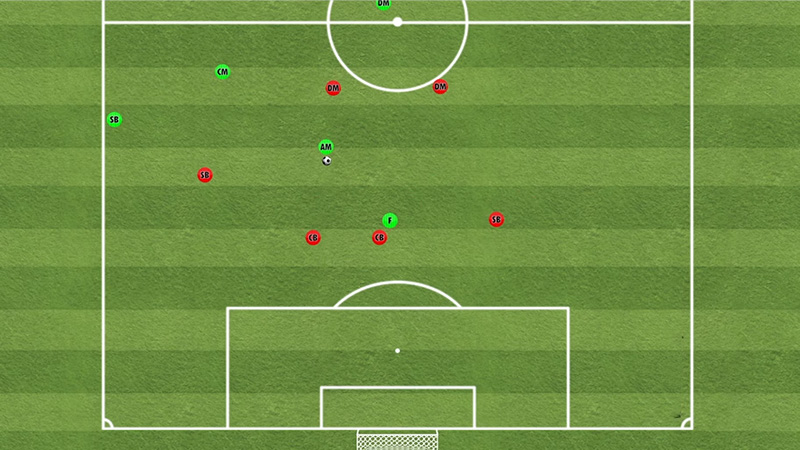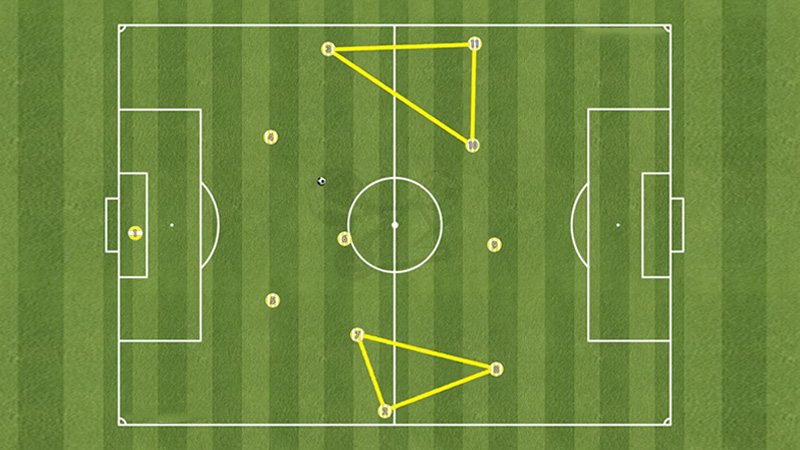In the realm of soccer, where strategy and skill intertwine, the midfield line holds a pivotal role as a defining boundary that shapes the dynamics of the game.
This imaginary line, positioned horizontally at the midpoint of the field, divides the pitch into two equal halves and acts as a reference point for players and coaches alike.
The midfield line marks the distinction between the defensive third and the attacking third, encompassing the crucial middle third where the battle for control and possession unfolds.
As players navigate this central battleground, the midfield line becomes a strategic zone where tactical formations are organized, the offside rule is enforced, and the transition between defence and attack is orchestrated.
In this article, we delve into what is the midfield line.
What Is The Midfield Line?
In soccer, the midfield line refers to an imaginary line that divides the field into two equal halves horizontally.
It is positioned at the midpoint of the field, running horizontally from one touchline to the other.
The midfield line plays a significant role in the game, as it helps define the areas of the field, influencing team strategies and tactics during a match.
Positional Importance
The midfield line serves as a crucial reference point for both teams during a game. For attacking teams, it marks the zone where they transition from the defensive third into the middle third and ultimately into the opponent’s attacking third.
For defensive teams, it signifies the area they aim to protect and regain possession when the opposing team tries to advance.
Tactical Significance
Coaches and players often use the midfield line to organize their tactical formations.
Teams can position their players strategically based on the phase of play, such as pressing higher up the pitch in the middle third or defending compactly in their defensive third.
The midfield line helps coaches convey instructions to players regarding their positioning and movement.
Offside Rule
The midfield line also plays a critical role in enforcing the offside rule. When an attacking player is beyond the second-last defender (excluding the goalkeeper) at the moment, the ball is played to them, and they are considered offside.
The midfield line, being at the halfway point, assists the officials in determining whether an offside position has occurred.
Midfield Battle
The midfield line is where much of the midfield battle takes place. Midfielders from both teams engage in duels to gain control of the ball, create passing opportunities, and orchestrate attacks.
Winning the midfield battle often determines which team dominates possession and has a higher chance of scoring goals.
Transition Zone
The midfield line represents the transition zone between defensive and offensive play. As possession changes hands, the midfielders play a crucial role in swiftly transitioning the game from one phase to another.
The ability to efficiently navigate the midfield line enables teams to launch quick counter-attacks or establish strong defensive shapes.
Overall, the midfield line is a fundamental element in soccer that influences the flow of the game and serves as a key reference point for players and coaches alike.
Its strategic placement on the field helps shape team tactics and contributes to the dynamic and exciting nature of the sport.
Effective Tips On The Midfield Line

Certainly! Here are some effective tips for excelling in the midfield line, each with a paragraph description:
Master Ball Control
Exceptional ball control is fundamental in the midfield line, where players often face tight marking and pressure from opponents.
Developing a soft first touch, close ball control, and the ability to shield the ball from defenders allows midfielders to retain possession and create passing opportunities.
Vision and Awareness
Midfielders must possess excellent vision and awareness of the entire field. Scanning the surroundings, identifying open spaces, and reading the movements of teammates and opponents enable players to make informed decisions and distribute the ball effectively.
Quick Decision-Making
The fast-paced nature of the midfield line demands quick decision-making. Players should assess their passing options, consider the game situation, and choose the best course of action promptly to maintain fluidity and prevent turnovers.
Precise Passing
Accurate passing is crucial in the midfield line, as misplaced passes can lead to counter-attacks for the opposition.
Players should work on their short and long-range passing skills, ensuring that they deliver the ball precisely to their teammates.
Tactical Discipline
Maintaining tactical discipline is essential in the midfield line. Players should adhere to their positional roles, support their teammates, and contribute to both offensive and defensive phases of play as required.
Energy and Endurance
The midfield line demands high levels of energy and endurance due to constant movement and involvement in the game.
Players should focus on fitness training and conditioning to sustain their performance throughout the match.
Pressing and Defensive Work
Effective pressing and defensive contributions are essential in the midfield line. Players should be proactive in closing down opponents, intercepting passes, and regaining possession for their team.
Timing Forward Runs
Well-timed forward runs can be game-changing in the midfield line. Players should make intelligent off-the-ball movements, creating passing options for teammates and adding an extra dimension to the team’s attacking play.
Communication
Clear and effective communication is vital for coordination in the midfield line. Players should communicate their intentions, call for the ball, and provide feedback to their teammates, enhancing teamwork and decision-making.
Transition Play
Mastering transition play is crucial in the midfield line. Players should quickly transition from defence to attack and vice versa, supporting their team’s movements and adapting to changing game scenarios.
Confidence and Composure
Finally, players in the midfield line must be confident and composed. Believing in their abilities and remaining calm under pressure allow midfielders to make sound decisions and positively impact the game.
By incorporating these effective tips into their playing style, midfielders can elevate their performance in the midfield line and become influential assets for their teams, contributing significantly to controlling the game’s flow and outcome.
FAQ
What is the midfield line in soccer?
Answer: The midfield line in soccer is an imaginary horizontal boundary that runs across the centre of the field, dividing it into two equal halves.
Positioned at the midpoint, the midfield line separates the attacking third (opponent’s half) from the defensive third (team’s own half), and it includes the crucial middle third where the battle for control and possession takes place.
How does the midfield line impact the game?
Answer: The midfield line plays a significant role in soccer, influencing various aspects of the game. It helps define different zones on the field, allowing players and coaches to organize tactical formations and positional play.
Why is the midfield line crucial for team strategies?
Answer: The midfield line is crucial for team strategies because it serves as a reference point for organizing players on the field. Coaches use the midfield line to convey tactical instructions, such as pressing higher up the pitch in the middle third or defending compactly in their own defensive third.
How does the midfield line impact the offside rule?
Answer: The midfield line is instrumental in enforcing the offside rule in soccer. When an attacking player is beyond the second-last defender (excluding the goalkeeper) at the moment the ball is played to them; they are considered offside.
Is the midfield line a physical marking on the field?
Answer: No, the midfield line is not a physical marking on the soccer field. It is an imaginary line that exists conceptually, dividing the field into two halves horizontally.
Conclusion
The midfield line stands as an invisible thread that weaves the fabric of soccer, intricately connecting tactical strategies, player movements, and moments of brilliance.
As players traverse this dividing boundary, the dynamics of the game shift and the battle for control intensifies. From orchestrating attacks to thwarting the opposition’s advances, the midfield line becomes a fulcrum for both offensive and defensive play.
The placement of players, the enforcement of the offside rule, and the fluidity of transitions all find their significance in this central realm of the field.
Understanding the essence of the midfield line unlocks the keys to unlocking success, empowering players and teams to embrace their roles in shaping the ebb and flow of the beautiful game.
As soccer continues to captivate the hearts of fans worldwide, the midfield line remains an intrinsic element, forever etched in the sport’s rich legacy.







